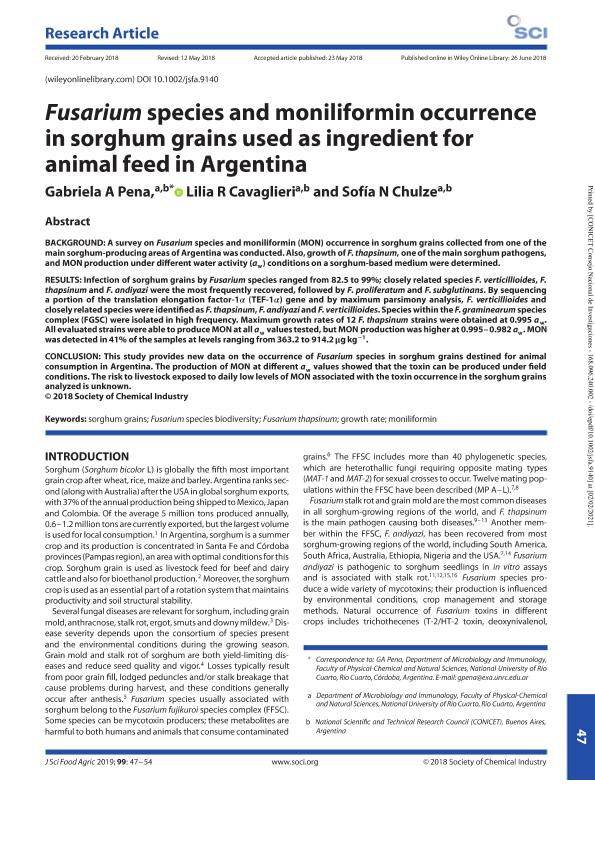Artículo
Fusarium species and moniliformin occurrence in sorghum grains used as ingredient for animal feed in Argentina
Fecha de publicación:
23/05/2018
Editorial:
John Wiley & Sons Ltd
Revista:
Journal of the Science of Food and Agriculture
ISSN:
0022-5142
e-ISSN:
1097-0010
Idioma:
Inglés
Tipo de recurso:
Artículo publicado
Clasificación temática:
Resumen
BACKGROUND: A survey on Fusarium species and moniliformin (MON) occurrence in sorghum grains collected from one of the main sorghum-producing areas of Argentina was conducted. Also, growth of F. thapsinum, one of the main sorghum pathogens, and MON production under different water activity (aw) conditions on a sorghum-based medium were determined. RESULTS: Infection of sorghum grains by Fusarium species ranged from 82.5 to 99%; closely related species F. verticillioides, F. thapsinum and F. andiyazi were the most frequently recovered, followed by F. proliferatum and F. subglutinans. By sequencing a portion of the translation elongation factor-1α (TEF-1α) gene and by maximum parsimony analysis, F. verticillioides and closely related species were identified as F. thapsinum, F. andiyazi and F. verticillioides. Species within the F. graminearum species complex (FGSC) were isolated in high frequency. Maximum growth rates of 12 F. thapsinum strains were obtained at 0.995 aw. All evaluated strains were able to produce MON at all aw values tested, but MON production was higher at 0.995–0.982 aw. MON was detected in 41% of the samples at levels ranging from 363.2 to 914.2 µg kg−1. CONCLUSION: This study provides new data on the occurrence of Fusarium species in sorghum grains destined for animal consumption in Argentina. The production of MON at different aw values showed that the toxin can be produced under field conditions. The risk to livestock exposed to daily low levels of MON associated with the toxin occurrence in the sorghum grains analyzed is unknown.
Archivos asociados
Licencia
Identificadores
Colecciones
Articulos(CCT - CORDOBA)
Articulos de CTRO.CIENTIFICO TECNOL.CONICET - CORDOBA
Articulos de CTRO.CIENTIFICO TECNOL.CONICET - CORDOBA
Citación
Pena, Gabriela Alejandra; Cavaglieri, Lilia Reneé; Chulze, Sofia Noemi; Fusarium species and moniliformin occurrence in sorghum grains used as ingredient for animal feed in Argentina; John Wiley & Sons Ltd; Journal of the Science of Food and Agriculture; 99; 1; 23-5-2018; 47-54
Compartir
Altmétricas




